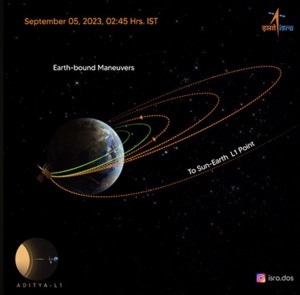Bengaluru, Sep 5: Early on Tuesday, the second earth-bound manoeuvre of Aditya L1, the first Indian mission to study the Sun in orbit, was successfully completed, according to ISRO. The mission was carried out by ISRO’s Telemetry, Tracking and Command Network (ISTRAC). “From ISTRAC, Bengaluru, the second Earth-bound movement (EBN#2) is successfully carried out. During this operation, the satellite was tracked by ISTRAC/ISRO ground stations in Mauritius, Bengaluru, and Port Blair. The new orbit obtained is 282 km by 40225 km, according to a statement from ISRO on X (formerly Twitter). It stated that the following manoeuvre (EBN#3) is planned for September 10, 2023, about 02:30 IST.The first observatory in India to study the Sun from space, Aditya-L1, is in a halo orbit around the first sun-earth Lagrangian point (L1), which is around 1.5 million kilometres from the planet. On September 3, the first earthbound movement was executed successfully. Before entering the transfer orbit towards the Lagrange point L1, the spacecraft will perform two more earth-bound orbital movements. After roughly 127 days, Aditya-L1 is anticipated to reach the planned orbit at the L1 point.On September 2, the Aditya-L1 spacecraft was successfully launched by ISRO’s Polar Satellite Launch Vehicle (PSLV-C57) from the Satish Dhawan Space Centre (SDSC), Sriharikota. The Aditya-L1 spacecraft was successfully injected into an elliptical orbit of 23519500 km around the globe after a mission period of 63 minutes and 20 seconds. A satellite positioned in a halo orbit around the L1 point, according to ISRO, has the significant benefit of continuously seeing the Sun without any occultation or eclipses. This will provide us a better opportunity to watch the solar activity and how it affects the space weather in real time.Aditya-L1 is carrying seven scientific payloads that were produced domestically by ISRO and national research organisations, including as the Inter University Centre for Astronomy and Astrophysics (IUCAA) in Pune and the Indian Institute of Astrophysics (IIA) in Bengaluru.
The payloads will use electromagnetic, particle, and magnetic field detectors to study the photosphere, chromosphere, and the Sun’s outermost layers (the corona).
Four payloads use the unique vantage point L1 to observe the Sun directly, while the remaining three payloads conduct in-situ particle and field studies at the Lagrange point L1. This allows for significant scientific research on the propagation of solar dynamics in the interplanetary medium.The most important data to comprehend the issue of coronal heating, coronal mass ejection, pre-flare and flare activities and their features, dynamics of space weather, and particle and field propagation is anticipated to be provided by the Aditya L1 payloads. A small object prefers to stay in one of five Lagrangian points (or parking areas) between the Earth and the Sun, according to scientists. The Italian-French mathematician Joseph-Louis Lagrange is the inspiration behind the name of the Lagrange Points, which he gave to his prize-winning article “Essai sur le Problème des Trois Corps, 1772.”These places in space allow spacecraft to spend more time there while using less fuel.
The centripetal force needed for a small object to travel with the Sun and Earth, which are at a Lagrange point, is equal to their gravitational attraction.

